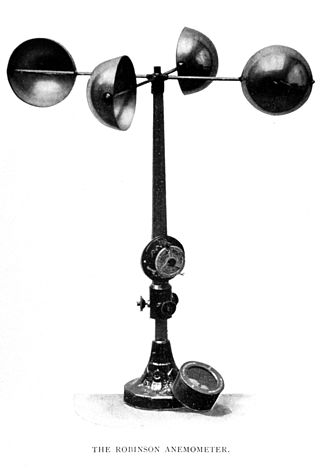
In meteorology, an anemometer is a device that measures wind speed and direction. It is a common instrument used in weather stations. The earliest known description of an anemometer was by Italian architect and author Leon Battista Alberti (1404–1472) in 1450.
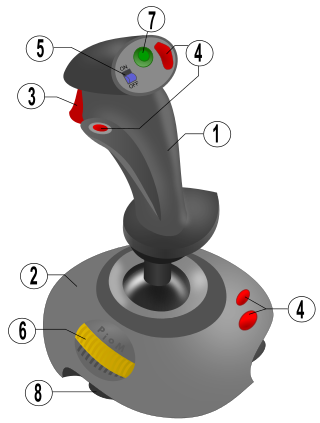
A joystick, sometimes called a flight stick, is an input device consisting of a stick that pivots on a base and reports its angle or direction to the device it is controlling. Also known as the control column, it is the principal control device in the cockpit of many civilian and military aircraft, either as a centre stick or side-stick. It has various switches to control functions of the aircraft controlled by the Pilot and First Officer of the flight.

Telemetry is the in situ collection of measurements or other data at remote points and their automatic transmission to receiving equipment (telecommunication) for monitoring. The word is derived from the Greek roots tele, 'far off', and metron, 'measure'. Systems that need external instructions and data to operate require the counterpart of telemetry: telecommand.

A potentiometer is a three-terminal resistor with a sliding or rotating contact that forms an adjustable voltage divider. If only two terminals are used, one end and the wiper, it acts as a variable resistor or rheostat.
A transducer is a device that converts energy from one form to another. Usually a transducer converts a signal in one form of energy to a signal in another. Transducers are often employed at the boundaries of automation, measurement, and control systems, where electrical signals are converted to and from other physical quantities. The process of converting one form of energy to another is known as transduction.
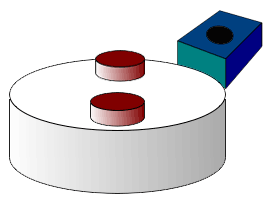
A Hall effect sensor is any sensor incorporating one or more Hall elements, each of which produces a voltage proportional to one axial component of the magnetic field vector B using the Hall effect.
In mechanical and control engineering, a servomechanism is a control system for the position and its time derivatives, such as velocity, of a mechanical system. It often includes a servomotor, and uses closed-loop control to reduce steady-state error and improve dynamic response. In closed-loop control, error-sensing negative feedback is used to correct the action of the mechanism. In displacement-controlled applications, it usually includes a built-in encoder or other position feedback mechanism to ensure the output is achieving the desired effect. Following a specified motion trajectory is called servoing, where "servo" is used as a verb. The servo prefix originates from the Latin word servus meaning slave.

The linear variable differential transformer (LVDT) – also called linear variable displacement transformer, linear variable displacement transducer, or simply differential transformer – is a type of electrical transformer used for measuring linear displacement. It is the base of LVDT-type displacement sensors. A counterpart to this device that is used for measuring rotary displacement is called a rotary variable differential transformer (RVDT).

A pitot–static system is a system of pressure-sensitive instruments that is most often used in aviation to determine an aircraft's airspeed, Mach number, altitude, and altitude trend. A pitot–static system generally consists of a pitot tube, a static port, and the pitot–static instruments. Other instruments that might be connected are air data computers, flight data recorders, altitude encoders, cabin pressurization controllers, and various airspeed switches. Errors in pitot–static system readings can be extremely dangerous as the information obtained from the pitot static system, such as altitude, is potentially safety-critical. Several commercial airline disasters have been traced to a failure of the pitot–static system.
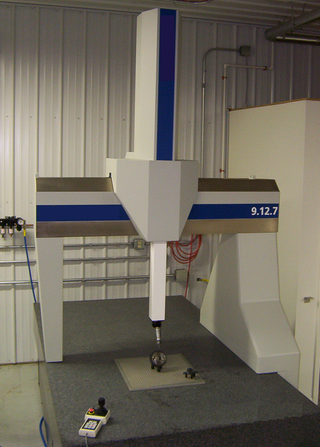
A coordinate-measuring machine (CMM) is a device that measures the geometry of physical objects by sensing discrete points on the surface of the object with a probe. Various types of probes are used in CMMs, the most common being mechanical and laser sensors, though optical and white light sensors do exist. Depending on the machine, the probe position may be manually controlled by an operator, or it may be computer controlled. CMMs(coordinate-measuring machine) specify a probe's position in terms of its displacement from a reference position in a three-dimensional Cartesian coordinate system. In addition to moving the probe along the X, Y, and Z axes, many machines also allow the probe angle to be controlled to allow measurement of surfaces that would otherwise be unreachable.
Level sensors detect the level of liquids and other fluids and fluidized solids, including slurries, granular materials, and powders that exhibit an upper free surface. Substances that flow become essentially horizontal in their containers because of gravity whereas most bulk solids pile at an angle of repose to a peak. The substance to be measured can be inside a container or can be in its natural form. The level measurement can be either continuous or point values. Continuous level sensors measure level within a specified range and determine the exact amount of substance in a certain place, while point-level sensors only indicate whether the substance is above or below the sensing point. Generally the latter detect levels that are excessively high or low.
An engine test stand is a facility used to develop, characterize and test engines. The facility, often offered as a product to automotive OEMs, allows engine operation in different operating regimes and offers measurement of several physical variables associated with the engine operation.
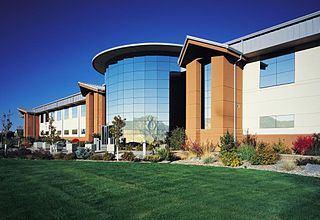
Bently Nevada is an asset protection and condition monitoring hardware, software and service company for industrial plant-wide operations. Its products are used to monitor the mechanical condition of rotating equipment in a wide variety of industries including oil and gas production, hydroelectric, wind, hydrocarbon processing, electric power generation, pulp and paper, mining, water and wastewater treatment. The company was founded in 1961 by Don Bently. Bently Nevada is headquartered in Minden, Nevada, about one hour south of Reno. Don Bently was the first to manufacture a commercially successful eddy-current proximity probe which measured vibration in high-speed turbomachinery by allowing the direct observation of the rotating shaft. The company also performed research in the field of rotordynamics, furthering knowledge of machinery malfunctions such as shaft cracks and fluid-induced instabilities. Its research also helped refine the equations used to describe vibratory behavior in rotordynamic systems.
A position sensor is a sensor that detects an object's position. A position sensor may indicate the absolute position of the object or its relative position (displacement) in terms of linear travel, rotational angle or three-dimensional space. Common types of position sensors include the following:
A string potentiometer is a transducer used to detect and measure linear position and velocity using a flexible cable and spring-loaded spool. Other common names include string pot, cable-extension transducer, draw wire sensor, and yo-yo sensor.

An air data boom provides air pressure, temperature, and airflow direction data to data acquisition systems for the computation of air, ground, and water vehicle orientation, speed, altitude/depth, and related information. Air data booms can be used as primary sensors or as a "measurement standard" of which primary sensors and instruments are compared to.

Capacitive displacement sensors are a kind of non-contact displacement sensor, measuring the position and change of position in capacitive materials to a high resolution. They are also able to measure the thickness or density of non-conductive materials. Capacitive displacement sensors are used in a wide variety of applications including semiconductor processing, assembly of precision equipment such as disk drives, precision thickness measurements, machine tool metrology and assembly line testing. These types of sensors can be found in machining and manufacturing facilities around the world.

Robotic sensors are used to estimate a robot's condition and environment. These signals are passed to a controller to enable appropriate behavior.

An airborne sensor operator is the functional profession of gathering information from an airborne platform and/or oversee mission management systems for academic, commercial, public safety or military remote sensing purposes. The airborne sensor operator is considered a principal flight crew or aircrew member.













